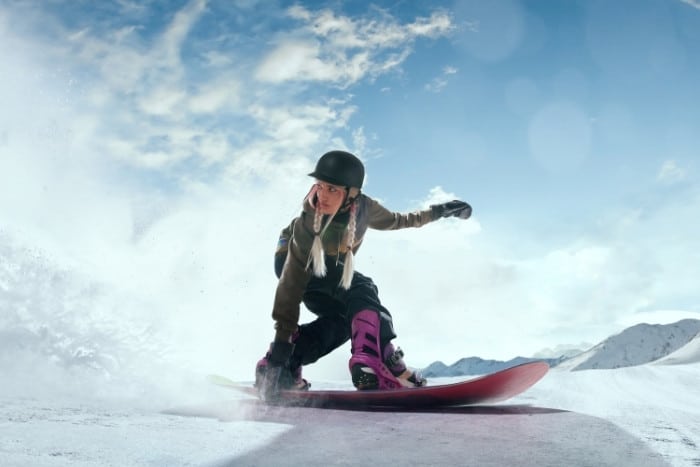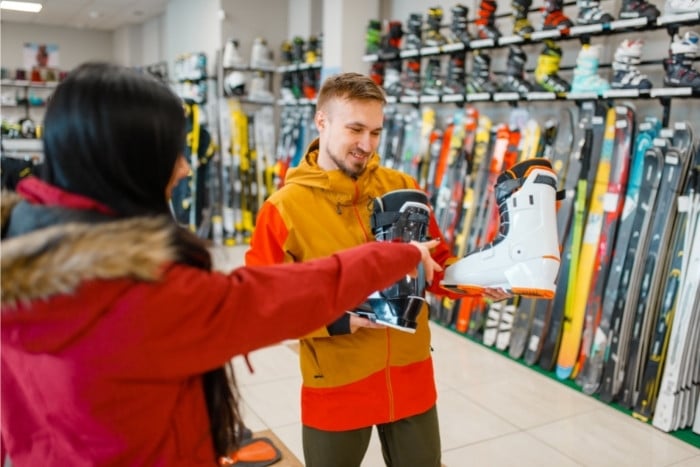Snowboarding boots come in various sizes, colors, and materials. If you are in the market for a new pair, you may have come across some stiff boots and may be wondering if they are fit for your snowboarding adventures. Weighing the pros and cons can help you make a quicker decision on whether or not they are worth having.
The pros of stiff boots include improved edge control and precision, stability, ankle support, profound carving ability, and shock absorption. The cons include discomfort, low maneuverability, delayed responsiveness, and high purchasing prices. Stiff boots may limit balance, especially for beginners.
The following is a deeper analysis of the perks and drawbacks of stiff boots.
Pros of Stiff Snowboarding Boots
Stiff snowboarding boots are often compared to soft snowboarding boots, which are made of flexible material and have more agility for freestyle snowboarders.
On the contrary, stiff boots are made of thick material which can withstand tough riding conditions while offering support for your feet.
Riding with stiff snowboarding boots has several advantages, including increased stability, shock absorption, and edge control.
Stiff boots improve your stamina by providing ankle support, and they distribute your weight on the snowboard, enabling you to ride, carve and turn precisely at high speed.
Let’s examine these further below.
1. Increased Stability
As a snowboarder, stability is essential to staying on your feet while riding through challenging terrain.
Stiff boots come in handy if you are big-bodied and tall since they are sturdy enough to hold on to the extra weight, which helps to keep you stable.
They increase stamina as they remain sturdy, taking the pressure off your feet when you ride through deep snow and making sharp turns.
Stiff boots are recommended for racers and others snowboarding at high speed.
They protect you from losing your balance when riding, jumping, and performing other stunts on your snowboard.
You can take an emergency turn or carve without falling due to the boot’s firm grip on your feet and calves.

2. Improved Edge Control and Precision
Edge control requires a precise application of pressure when carving.
Stiff boots improve your ability to tilt your snowboard’s edge and cut through the snow without sliding out as they exert more pressure on the board when your body makes a turn.
Stiff boots are essential when riding at high speed, as you must apply more pressure and control on the edge of your snowboard.
In case you want to learn how to ride fast, we have an article to help you snowboard much faster than you currently do.
They make it easy to carve, turn or break into a stop without falling off the board.
3. Ankle Support
Your ankles need ample protection as you ride, carve, and turn on your snowboard. Our article on going zig-zag and linking turns while riding will help you more.
Stiff boots are made of thick material to support your ankles while maintaining flexibility for easy control.
Most manufacturers use quality materials that stiffen the boot on the outside without interfering with internal comfort.
You can adjust the bindings for more support, depending on the nature of your ride.
4. Shock Absorption
When landing from a jump, your lower body is subjected to pressure that distributes to the knees and feet.
Stiff boots absorb the shock and increase energy transfer on the board, minimizing the effects of your landing.
The controlled impact also reduces the chances of getting injuries.
Additionally, snowboarding on challenging terrains exerts pressure on your body.
Stiff snowboarding boots take up the pressure, distributing it throughout the snowboard, protecting your ankles, feet, and knees from the shock.
5. Deep Carving Ability
Deep carves require speed and stability as you make sharp turns on your snowboard’s side cut.
As you carve through small sections of the area on which you’re riding, your feet must fit nicely inside the boot to avoid twisting and manage the occasional pressure.
Stiff boots stabilize your feet in a steady position to avoid movement as you carve.
They also maintain your toe edge as you push your weight over them to enhance the carves.
You’ll also need to push your shins against the boots’ tongues for firm support to avoid falling over when carving.
Stiff boots can withstand the extra energy and keep you moving.
6. Enhanced Freeriding on Backcountry Trails
Backcountry snowboarding occurs in unmarked terrains, slopes, and deep snowy wildernesses when you want to get more adventurous.
These regions require tough gear and a snowboard that’s able to handle the conditions.
You need stiff boots for backcountry freeriding to get you through the unkept terrains with minimal struggles.
As mentioned earlier, these boots offer support, shock distribution, and stability, which are essential for backcountry snowboarding.
7. Reinforced Material, Spines, and Tongues
Stiff snowboarding boots last longer despite handling harsh riding conditions because of their reinforced material, spines, and tongues.
The stiffness of the boots’ material increases your ability to cut into hard packs and thick snow with minimal effort.
You can unleash your aggressiveness at full throttle, assured of protection from injuries by the tough material used to construct the boots.
The adjustable lace systems make it easy to increase and reduce the boot’s grip to fit your particular needs.

Cons of Stiff Snowboarding Boots
Despite the numerous perks of stiff snowboarding boots, we can’t ignore the multiple drawbacks.
The cons of stiff snowboarding boots include the lengthy break-in period, causing discomfort during the first few times wearing them.
They are expensive due to the complex techniques used in their production, and beginners may require more practice to improve their maneuverability.
1. Longer Break-in Period
Stiff snowboarding boots take time to grow compatible with your feet, leading to a longer break-in period.
You may experience discomfort when wearing the boots for the first time, and the feeling can proceed for a while.
You may also face challenges when flexing and pressing on your snowboard with the stiff boots as they barely bend to accommodate these movements.
2. Relatively Expensive
Stiff boots are more expensive than soft and semi-stiff boots. Many materials are used to stiffen the boots and ensure they are usable for a long period.
The additional mechanisms set to enhance shock absorption, adjustability, and traction increase the production cost of stiff boots, which is later transferred to the buying cost.
3. Challenging for Beginners
If you are a beginner in snowboarding, stiff boots may be challenging to use.
You may have problems with the maneuverability and stability since they make it harder to grab the snowboard and perform flexes.
The tough material and reinforced spines make it hard to control your movements if you are not used to snowboarding.
It’s advisable to first practice riding on softer boots before gradually transitioning to stiff ones.
4. Slower Turns
Stiff boots are heavier than soft boots due to the rigid material used to make them, which may slow down performances like turns and delay responsiveness.
They can also feel heavy, especially when worn for the first time, and you may need more practice to adjust to their weight and rigidity before your turns get faster.
Final Thoughts
Shopping for snowboarding boots requires you to compare the pros and cons to understand what you’re getting yourself into.
The pros of stiff boots include stability, increased edge control, shock absorption, and the ability to make deep carves.
However, these boots come with discomfort, delayed responsiveness, and added costs, making them more expensive than other types.
You may also need to consider your snowboarding expertise, body size, and height to ensure the stiff boots are compatible.
